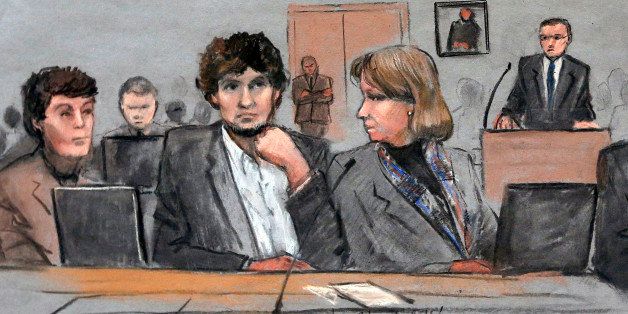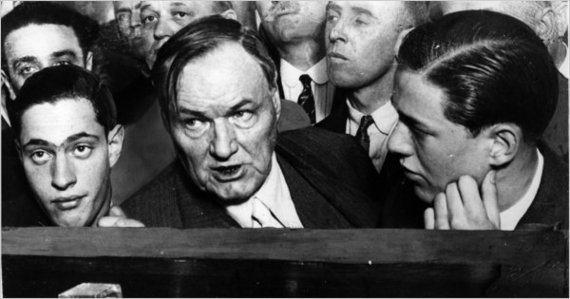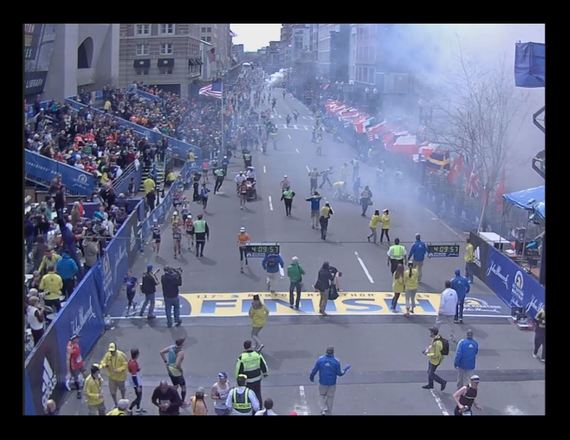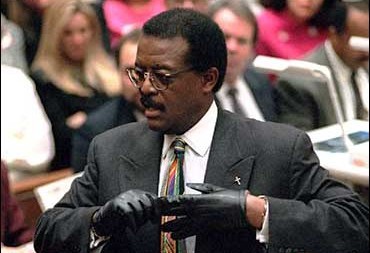
 Clarence Darrow in 1924, with his clients, Nathan Leopold, left, and Richard Loeb, right. Credit United Press International
Clarence Darrow in 1924, with his clients, Nathan Leopold, left, and Richard Loeb, right. Credit United Press International
After weeks of testimony and 96 witnesses a jury this week found admitted Boston Marathon Bomber, Dzhokhar Tsarnaev, guilty on all 30 charges. Seventeen of them are punishable by death. The trial now enters the penalty phase. Legal experts argue that a powerful or weak closing argument has represented the difference between life in prison or execution. The strategy of the Tsarnaev defense team echoes an earlier trial. The closing argument in that case is believed to have saved two lives.
The year was 1924.
Guilt was never the issue. The defense lawyer's objective was to avoid the death penalty. And from the beginning of the trial the lead defense lawyer conceded his clients' culpability. Reporters from around the country and the world flocked to the courthouse, where they witnessed what legal historians consider perhaps the most masterful closing argument ever. History is still waiting to judge the conclusion of the Boston Marathon Bombing trial. But in the Tsarnaev case and many others, the standard that defense attorneys and prosecutors have tried to live up to for nearly a century has been the 12-hour closing argument by Charles Darrow in the trial of Leopold and Loeb.
Your honor, I have stood here for three months as one might stand at the ocean trying to sweep back the tide. I have heard nothing in the last few weeks but nothing for a cry for blood. I never saw such enthusiasm for the death penalty as I've seen here. It's been discussed as a holiday, like a day at the races. I've heard words from the state's attorney that would shame a savage.
The words of Clarence Darrow in a Chicago courtroom -- word for word -- in his famous defense of two wealthy teenagers, Nathan Leopold and Richard Loeb, who kidnapped and bludgeoned to death 14-year-old Bobby Franks, just for the hell of it. Like attorney Judy Clark in her defense of Dzhokhar Tsarnaev, Charles Darrow's argument was strictly aimed at keeping his two clients off death row.
Actor Kevin Spacey playing Clarence Darrow
Would hanging them make mankind better or worse? Would it make the human heart softer or would it make it harder? If the state in which I live in is not kinder, more humane than the mad act of these two boys, I am sorry I have lived so long.
Daniel Medwed -- who teaches Criminal Law at Northeastern University says Darrow elevated the closing argument to an art form.
"Good old Clarence Darrow was renowned to sing a good song or two during closing argument"
An example of a closing said Medwed, that any good defense lawyer or prosecutor would be wise to emulate.
"The best closing arguments are a combination of stating your theory of the case, your theme, in a very memorable way, while also touching upon the key pieces of evidence, and the appropriate inferences from those pieces of evidence," said Medwed.
"So what I mean by this is that the trial is very strictly governed by the rules of evidence. And lawyers in many respects are shackled. They're restricted in what they can say and what they can do by the rules of evidence and by the rules of procedure. By the time of closing arguments those shackles are removed."
Medwed added: "If you exceed those bounds; if you appeal baldly to passion to prejudice, than that's unethical and you will be held accountable. But within the parameters of closing arguments there's a great deal of autonomy, and so it allows in some respects for tremendous theater."
Gretchen Greene of Cambridge sees the closing trial argument from a unique perspective. She is both an accomplished attorney and a successful sculptor.
"Well both for an artist and a lawyer in crafting a closing argument and all the way through the trial, you're choosing a viewpoint. The job of a lawyer in a closing argument is to present a vision, much like the job of a sculptor or a photographer. So they present an idea, a story and try to make it so compelling to the jury that this is the only vision they can remember."
The picture painted by the prosecution -- for example -- in the trial of Dzhokhar Tsarnaev was a picture of premeditation. Prosecutors emphasized the callousness of Tsarnaev setting off a bomb inches away from an 8-year-old boy watching racers on Marathon Day, and then crossing the Charles river into Cambridge to buy milk at Whole Foods. 
Moments after the bombs went off near the Boston Marathon finish line
What mercy is it to lock up two boys for life? Where is the human heart that will not be satisfied with that -- Clarence Darrow
Clarence Darrow also faced a prosecutor who described in his closing argument how Leopold and Loeb, having wrapped their 14-year old victim in a robe and stuffed him in the back of a car, stopped at a restaurant for hot dogs and root beer.
Darrow succeeded in his closing argument in convincing the trial judge to spare the lives of Leopold and Loeb.
"Your honor, I'm not asking for mercy here. What mercy is it to lock up two boys for life? Where is the human heart that will not be satisfied with that?"
Leopold and Loeb were sentenced to life plus 99 years. But a jury trial may have produced a different outcome. Robert Bloom, a professor of law at Boston College, said even artful closing arguments can be undermined by peer pressure and strong juror personalities:
"It's tough. The collective wisdom of the jurors is often led by three or four strong jurors within that setting. So you want to give them arguments that they can use in the jury room to make their cases. So you're basically arguing to the whole group and it's the hope that your arguments will be convincing to some of them and they will bring it to the jury room and make the same argument to their peers."
The closing arguments in the trial of Dzhokhar Tsarnaev will be treated as either footnotes in a chapter on America's war on terrorism or they will be held up as modern examples of artful and effective courtroom jiu-jitsu. But Medwed said memorable and artful closings are more unusual than one would think:
"I think in our lifetime the OJ Simpson trial is one of the more memorable ones, with Johnny Cochran, one of the great trial lawyers of the 20th Century getting up there and saying about the glove, 'if it doesn't fit you must acquit.' That's an example of theatrics, having a dramatic tag line, a memorable tag line, but ties in nicely and neatly with the evidence in the case."
Gretchen Green, attorney and professional sculptor, said the art of the courtroom closing argument rest in the ability of lawyers to project their interpretation of reality onto the evidence.
"For a lawyer presenting a case, it might seem if I say that a lawyer chooses the story to tell and chooses the story, the vision to try to present to champion before the jury that somehow they're telling less than the truth. But there is no one truth," said Greene.
"There are all these choices that could have been made. All the jury can do is to choose one story to fit the facts and evidence that were presented. And it is for the lawyer to try to present the vision of a single story, which is so compelling that when the closing argument begins there are many possible stories, and when the lawyers rest their case, there is only one."
